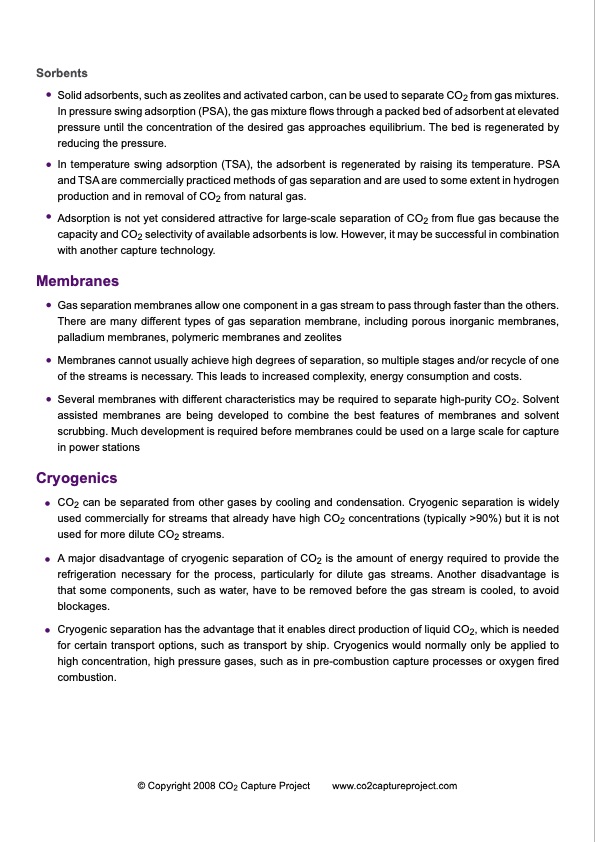
PDF Publication Title:
Text from PDF Page: 002
Sorbents Solid adsorbents, such as zeolites and activated carbon, can be used to separate CO2 from gas mixtures. In pressure swing adsorption (PSA), the gas mixture flows through a packed bed of adsorbent at elevated pressure until the concentration of the desired gas approaches equilibrium. The bed is regenerated by reducing the pressure. In temperature swing adsorption (TSA), the adsorbent is regenerated by raising its temperature. PSA and TSA are commercially practiced methods of gas separation and are used to some extent in hydrogen production and in removal of CO2 from natural gas. Adsorption is not yet considered attractive for large-scale separation of CO2 from flue gas because the capacity and CO2 selectivity of available adsorbents is low. However, it may be successful in combination with another capture technology. Membranes Gas separation membranes allow one component in a gas stream to pass through faster than the others. There are many different types of gas separation membrane, including porous inorganic membranes, palladium membranes, polymeric membranes and zeolites Membranes cannot usually achieve high degrees of separation, so multiple stages and/or recycle of one of the streams is necessary. This leads to increased complexity, energy consumption and costs. Several membranes with different characteristics may be required to separate high-purity CO2. Solvent assisted membranes are being developed to combine the best features of membranes and solvent scrubbing. Much development is required before membranes could be used on a large scale for capture in power stations Cryogenics CO2 can be separated from other gases by cooling and condensation. Cryogenic separation is widely used commercially for streams that already have high CO2 concentrations (typically >90%) but it is not used for more dilute CO2 streams. A major disadvantage of cryogenic separation of CO2 is the amount of energy required to provide the refrigeration necessary for the process, particularly for dilute gas streams. Another disadvantage is that some components, such as water, have to be removed before the gas stream is cooled, to avoid blockages. Cryogenic separation has the advantage that it enables direct production of liquid CO2, which is needed for certain transport options, such as transport by ship. Cryogenics would normally only be applied to high concentration, high pressure gases, such as in pre-combustion capture processes or oxygen fired combustion. © Copyright 2008 CO2 Capture Project www.co2captureproject.comPDF Image | Three basic methods to separate gases

PDF Search Title:
Three basic methods to separate gasesOriginal File Name Searched:
3_basic_methods_gas_separation.pdfDIY PDF Search: Google It | Yahoo | Bing
CO2 Organic Rankine Cycle Experimenter Platform The supercritical CO2 phase change system is both a heat pump and organic rankine cycle which can be used for those purposes and as a supercritical extractor for advanced subcritical and supercritical extraction technology. Uses include producing nanoparticles, precious metal CO2 extraction, lithium battery recycling, and other applications... More Info
Heat Pumps CO2 ORC Heat Pump System Platform More Info
| CONTACT TEL: 608-238-6001 Email: greg@infinityturbine.com | RSS | AMP |